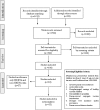Streptococcus pneumoniae serotype 19A in Latin America and the Caribbean: a systematic review and meta-analysis, 1990-2010
- PMID: 22639955
- PMCID: PMC3475047
- DOI: 10.1186/1471-2334-12-124
Streptococcus pneumoniae serotype 19A in Latin America and the Caribbean: a systematic review and meta-analysis, 1990-2010
Abstract
Background: Pneumococcal conjugate vaccines (PCVs) are in the process of implementation in Latin America. Experience in developed countries has shown that they reduce the incidence of invasive and non-invasive disease. However, there is evidence that the introduction of PCVs in universal mass vaccination programs, combined with inappropriate and extensive use of antibiotics, could be associated to changes in non-PCV serotypes, including serotype 19A. We conducted a systematic review to determine the distribution of serotype 19A, burden of pneumococcal disease and antibiotic resistance in the region.
Methods: We performed a systematic review of serotype 19A data from observational and randomized clinical studies in the region, conducted between 1990 and 2010, for children under 6 years. Pooled prevalence estimates from surveillance activities with confidence intervals were calculated.
Results: We included 100 studies in 22 countries and extracted data from 63. These data reported 19733 serotyped invasive pneumococcal isolates, 3.8% of which were serotype 19A. Serotype 19A isolates were responsible for 2.4% acute otitis media episodes, and accounted for 4.1% and 4.4% of 4,380 nasopharyngeal isolates from healthy children and in hospital-based/sick children, respectively. This serotype was stable over the twenty years of surveillance in the region. A total of 53.7% Spn19A isolates from meningitis cases and only 14% from non meningitis were resistant to penicillin.
Conclusions: Before widespread PCV implementation in this region, serotype 19A was responsible for a relatively small number of pneumococcal disease cases. With increased use of PCVs and a greater number of serotypes included, monitoring S. pneumoniae serotype distribution will be essential for understanding the epidemiology of pneumococcal disease.
Figures



References
-
- Lynch JP 3rd, Zhanel GG. Streptococcus pneumoniae: epidemiology and risk factors, evolution of antimicrobial resistance, and impact of vaccines. Curr Opin Pulm Med. 2010;16:217–225. - PubMed
-
- O'Brien KL, Wolfson LJ, Watt JP, Henkle E, Deloria-Knoll M, McCall N, Lee E, Mulholland K, Levine OS, Cherian T. Burden of disease caused by Streptococcus pneumoniae in children younger than 5 years: global estimates. Lancet. 2009;374:893–902. doi: 10.1016/S0140-6736(09)61204-6. Hib and Pneumococcal Global Burden of Disease Team: - DOI - PubMed
-
- Johnson HL, Deloria-Knoll M, Levine OS, Stoszek SK, Freimanis Hance L, Reithinger R, Muenz LR, O'Brien KL. Systematic evaluation of serotypes causing invasive pneumococcal disease among children under five: the pneumococcal global serotype project. PLoS Med. 2010;7:e1000348. doi: 10.1371/journal.pmed.1000348. - DOI - PMC - PubMed
-
- Satzke C, Ortika BD, Oftadeh S, Russell FM, Robins-Browne RM, Mulholland EK, Gilbert GL. Molecular epidemiology of Streptococcus pneumoniae serogroup 6 isolates from Fijian children, including newly identified serotypes 6C and 6D. J Clin Microbiol. 2010;48:4298–4300. doi: 10.1128/JCM.00861-10. - DOI - PMC - PubMed
Publication types
MeSH terms
Substances
LinkOut - more resources
Full Text Sources
Medical

